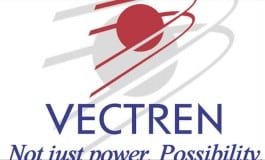Vectren, a CenterPoint Energy company, today announced it is implementing the next stage of the 2017 Senate Enrolled Act 309 (SEA 309). The filing with the Indiana Utility Regulatory Commission (IURC) will cap compensation to customer-owned distributed generation and proposes a new rate reflecting the actual market cost of electricity. This change benefits the 99 percent of customers who do not own their own generation by reducing the cost all customers must pay to subsidize private renewable generation.
Customers with private generation resources designed to serve their own needs receive above market compensation when their generation facilities distribute excess power to the grid. The law details how distributed generation customers are compensated, which shifts costs to all remaining customers. Today, the compensation is equal to Vectren’s retail kilowatt hour charge for service. The rate that Vectren can purchase similar generation for customers on the open market is typically 25 to 30% of the retail rate.
The 2017 law changes the compensation paid to customers distributing excess power to the grid to a rate much closer to the wholesale market rate of power. This ensures that customers who install their own generation continue to be compensated for excess electricity they send to the grid, but at rates that are more fair for other customers. The law grandfathers customers who have already invested in generation based on the retail rates by ensuring they continue to receive that rate until 2032 or 2047, depending on the date they installed facilities.
“We will continue to promote, support and work with customers who install private generation while ensuring all customers are treated fairly,†said Lynnae Wilson, chief business officer, Indiana Electric.
Under SEA 309, the net metering cap, or maximum amount of distributed generation on Vectren’s system that is credited at the full retail price for energy, accounts for 1.5% of Vectren’s retail peak load. Therefore, the total amount of distributed generation that qualifies for Vectren’s net metering program is 15.8 megawatts (MW). Of the 15.8 MW:
- 40% of the 15.8 MW must be reserved for residential customers; and
- 15% of the 15.8 MW must be reserved for biomass/agricultural projects.
SEA 309 states that if the 1.5% cap is reached prior to July 2022, all customers who install distributed generation and interconnect with Vectren thereafter will be credited at the wholesale market rate plus a 25% premium for excess power put on the grid.
The IURC requires that Vectren maintain a defined queue for each specific customer category, which is provided publicly on www.vectren.com/information/customer-generation. Today, Vectren has more than 600 customers in its net metering program providing capacity of over 11 MW. These customers need to take no action and will automatically be grandfathered for 15 or 30 years from the date SEA 309 was enacted.
The proposed tariff for customers with existing systems, as well as for those who plan to install are as follows:
Customers with systems that were installed by Dec. 31, 2017, will continue to be credited at the full retail price* for excess power put on the grid until 2047. After 2047, excess power will be credited at the wholesale market price** plus a 25% premium;
- Customers with systems installed after Dec. 31, 2017 through the date of the approval of the filing will be credited at the full retail price for excess power put back on the grid until 2032. After 2032, excess power will be credited at the wholesale market price plus a 25% premium;
- Customers who are currently in Vectren’s queue with an approved interconnection application will be credited at the full retail price for excess power put back on the grid until 2032. After 2032, excess power will be credited at the wholesale market price plus a 25% premium;
- Customers who receive an approved interconnection application by December 31, 2020 will be credited at the full retail price for excess power put on the grid until 2032. After 2032, excess power will be credited at the wholesale market price plus a 25% premium; and
- Customers with applications approved after Dec. 31, 2020 will be credited at the wholesale market rate plus a 25% premium for excess power put on the grid.
Â







